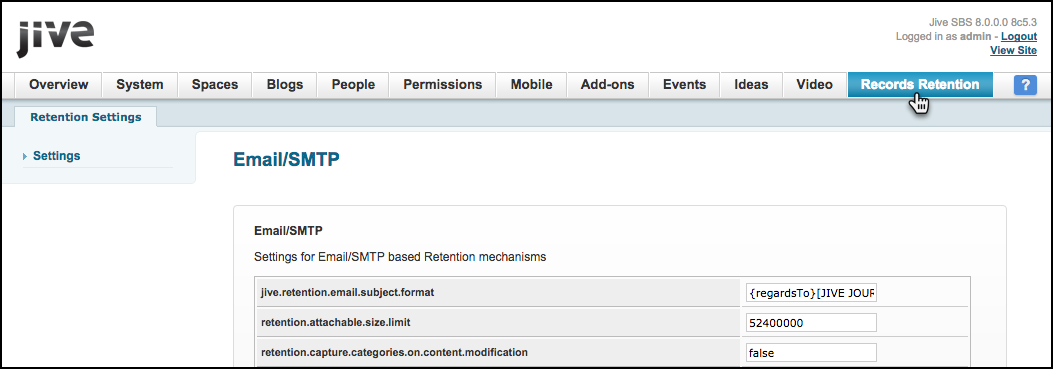Configuring Records Retention for XML
When configuring Records Retention, you set it to deliver information as an XML file to the Jive server binstore.
Enabling Records Retention for XML
When configuring Records Retention for XML, you enable the Records Retention plugin and set the parameters to deliver the gathered information into the Jive server binstore.
To enable Records Retention:
Records Retention properties for XML
When configuring Records Retention for XML you must set at least the required properties. Additionally, you can set other useful properties.
Once you enable the Records Retention plugin, you can configure it for your environment from the Records Retention tab. This tab contains a list of configurable settings.
Required properties
The following properties must be changed to set up Records Retention for XML:
retention.xml.output.file.directory.name: The directory where the retention files are saved.retention.xml.directory.to.put.final.file: The directory where completed retention files are copied.retention.xml.output.file.filename.prefix: The filename prefix for the retention files. The remainder of the filename includes a timestamp to uniquely identify it.
Additional useful properties
The following properties are optional and can be changed as desired:
jive.retention.email.subject.format: How the email subject is formatted. The default is{regardsTo}[JIVE JOURNAL] - {subject}. However, this value may be replaced with any hard-coded strings, along with the following replacement keys:{regardsTo}: Includes "Re:" on comments, replies, and other non-root entries{subject}: Includes the raw subject or title of the root entry{contentType}: Includes the content type of the event{actionType}: Includes the action type of the event{objectId}: Includes the ID of the item affected by the event{objectType}: Includes the type of the item affected by the event{rootId}: Includes the ID of the root entry of the affected conversation{rootType}: Includes the type of the root entry of the affected conversation
For example, set this property to
{subject}to include only the raw title of the conversation with no additional formatting.retention.comma.separated.emails.for.error.reporting: A list of comma-delimited email addresses used for error reporting. If the XML creation fails (and is recoverable), an email is sent to each email address listed in this setting.retention.deletes.processing.on: Whether to capture or delete events. Defaults tofalse. Note that delete records have very little information about the content that was deleted.retention.error.reporting.email.subject: Subject string for the error reporting email. If the XML creation fails (and is recoverable), an email is sent with this value as the subject.retention.include.author.details: Whether to include author details in the header. Defaults tofalse. Set this property totrueto add anX-AuthorUsernameheader with the author's username as the value.retention.reaper.actiancefile.number.of.days.to.keep: The number of days for which completed XML files are kept.retention.reaper.messagearchive.number.of.days.to.keep: The number of days for which records are retained after they are sent. Records can be saved for a while, so that you can replay events. Defaults to30.retention.reaper.messagearchive.number.of.days.to.keep: The number of days for which records are retained after they are sent. Records can be saved for a while, so that you can replay events. Defaults to30.retention.resolve.and.store.cclists.for.spaces: Whether to send activity to emails specified in the settings for a given space. Defaults totrue. This feature can be turned off to improve performance.
